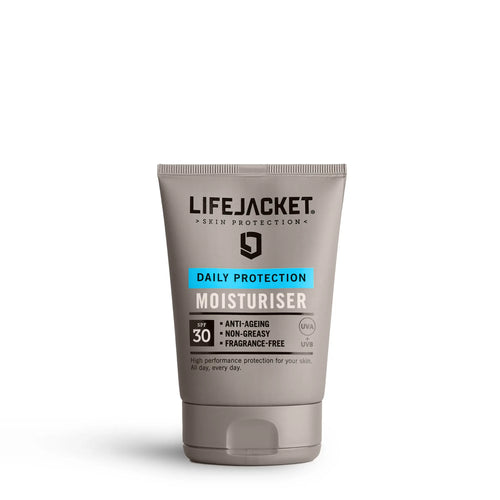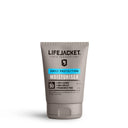The chances are that if you're heading to the mountains - no matter your activity of choice - you'll be outside and active for long periods while exposed to potentially harsh elements.
Experiencing the outdoors, discovering new places and being surrounded by incredible scenery are just some of the magical aspects of being up in the mountains.
However, altitude can also wreak havoc on your skin: ice-cold winds, extreme ultraviolet (UV), low humidity and sweating can all contribute to skin issues.
To make sure your skin doesn't wipeout, we put together a few tips so your skin can survive one of the harshest environments it comes into contact with.
First job: understand your skin
Think of your skin as the first line of defence against outside elements.
The skin's major role is to protect your body from environmental 'stressors', extreme weather and harsh conditions. These environmental stressors attack your skin on a daily basis.
If your skin becomes damaged or compromised, it might not be able to perform it's main job of protecting you. And that could mean things like bacteria or viruses getting inside your body.
Skin damage can be anything on a spectrum from soreness, dryness, redness, cracking, spots, itchiness, wrinkles or sensitivity, all the way to skin cancer (and thousands of other things in between).
Six skin protection tips for time in the mountains
So you can enjoy the mountains to their fullest and focus on the reasons you're there (and not the painful side-effects), here are five tips on skin safety at altitude, including why we think they're important.
1. BE VERY UV-AWARE
For years, goggle marks and a face tan have been a status symbol for a well-enjoyed ski trip. Nowadays, people are more aware of the serious and damaging effects the sun's UV light can have on our skin. This couldn't be more true at altitude, for two reasons.
Firstly, you're 1,500+ metres closer to the sun which sounds obvious because it is. But also the air is thinner and cleaner at altitude so less UV is filtered out. The cumulative effect of this means UV levels increase by 10% for every 1,000 metres above sea level, according to the World Health Organization.
In addition to this, light reflection plays a major role in increasing your UV exposure on a mountain. In winter, UV hits you twice: once from the sun and again, as it bounces off snow and back onto you, almost doubling your exposure.
For these reasons, a mountain is one of the harshest UV environments you can find yourself in. Even during a winter whiteout, damaging UV passes through cloud cover as many of us can attest to having got home, red-faced and confused.
While UVB is the wavelength of solar radiation that causes the skin to burn or go red, UVA causes deeper and less visible damage. It's worth nothing that both are responsible for 80% of premature skin ageing and 90% of melanoma skin cancers.
Use an SPF 50+ product (with the UVA circle sign or 5* Ultra) on any exposed skin. Reapply at every coffee or hot chocolate break. Don't get caught out. For summer mountaineers, UPF 50+ clothing is a neat solution because it's the ultimate physical barrier while being lightweight and sweat-proof.
2. MOISTURE
There's so much going against you at altitude when it comes to maintaining skin moisture: low humidity, ice cold winds, water loss in the form of perspiration, regular switching between inside and out, and hot showers, just to name a few of the main culprits.
We wrote an entire piece on skin moisture but in short, skin dryness can causes itchiness, cracking and discomfort. The cold means our skin produces less sebum. All skin types, even greasy skin, need extra care.
Over moisturise (if that makes sense). Beginning of the day and end of the day religiously. Use a heavier moisturiser than you might be used to as it will provide a thicker layer, or barrier, on the surface of your skin. As hard as this is after a long day in ski boots, try to avoid long, hot showers. Warm is your friend.
3. LIPS
Even if your lips don't normally need any special attention, they probably will do in the mountains. Lips don't produce sebum so can quickly become dry. They also burn more easily than other areas of skin.
Keep an SPF lip balm in your pocket for both UV protection and moisture. Reapply constantly throughout the day.
4. EYES
When skiing or mountaineering, protecting your eyes against sunlight and glare from snow and ice is really important for your eye health. As mentioned, UV levels can be high even on a cloudy day and overexposure can lead to painful inflammation, known as 'snow blindness'. It can also increase the likelihood of developing cataracts.
Sunglasses or goggles with UV400 protection (or which have the CE kite mark) are a critical piece of kit. Low quality lenses can cause more harm than good as you can read in our blog post devoted to eye protection.
5. DRINK
Healthy skin contains about 30% water, which is essential for maintaining the skin’s elasticity, strength and structure. If that drops even slightly, it can lead to dehydrated skin.
Up to half a litre of water evaporates from your skin each day, at rest, in a cool environment. This can increase to as much as 10 litres while exercising.
Maintain cellular moisture from the inside out and drink up. This really is one of the best ways to keep your skin moisture levels high. Assuming you're skiing, hiking, walking, climbing etc. you'll also be sweating in which case, drink more than you usually would.
6. END OF DAY RECOVERY
After hours outdoors, try to get into the habit of helping your skin recover.
In simple terms, we mean cleanse and moisturise. This can take as little as 30 seconds and it will really help the skin repair itself after harsh exposure at altitude.
Moisturisers can do two things depending on their ingredients: form a layer to block water leaving or try and add water to the epidermis. Use what you like and apply at the end of the day.
Apply straight after a bath or shower to seal in moisture while your skin is damp. Don’t forget about your hands and body – they definitely won’t say no to a daily layer of added moisture.






